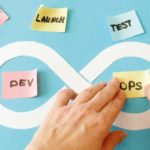Large Scale Scrum (LeSS) explained

Large Scale Scrum (LeSS): this article explains Large Scale Scrum (LeSS) in a practical way. After reading you will understand the basics of this powerful Agile software development framework.
Other highlights are: what it is, the two types of configurations and the principles of LeSS. Next to that, this article also explains the differences between LeSS and the traditional scrum method, and the benefits.
Finally, this article highlights how you can initiate LeSS in your work environment.
What is Large Scale Scrum (LeSS)?
Large Scale Scrum is an agile software development framework where the work is divided among different teams. Each team works on a few tasks or projects at the same time in so-called sprints.
The original Scrum method was developed for small independent teams. One way of using the same approach for larger and multiple teams is called Large Scale Scrum (LeSS).
LeSS is used by companies with several multifunctional teams that vary in size, from tens to thousands of team members.
The 2 configurations of Large Scale Scrum (LeSS)
There are two configurations for this software development framework:
- Basic LeSS: scrum for two to eight teams
- LeSS Huge: scrum for more than 8 teams (50-6.000+ people)
LeSS Huge starts with Basic LeSS. Then a key role is added: the Area Product Owner (APO). Additional artifacts are added, as well as changes in the way meetings are held.
Organizations are advised to practice with Basic LeSS before switching to LeSS Huge. Two proposed approaches are recommended from the method for the adoption of LeSS Huge:
- Start with a pilot area, targeting an area of need within the bigger picture
- Gradually expand team scope and responsibilities
That allows an organization to build experience with LeSS on a smaller scale and get management support before scaling it up across the organization.
Principles of Large Scale Scrum (LeSS)
The LeSS Company defines 10 principles for applying scrum in an organization. These help to develop responsible teams that are customer-oriented and collaborate intensively. The full list of principles behind scrum is mentioned below.
- Large-scale scrum is scrum
- Empirical process control
- Transparency
- More with less
- Whole-product focus
- Customer-centric
- Continuous improvement towards perfection
- Systems thinking
- Lean thinking
- Queue Theory
Large Scale Scrum (LeSS) is just a method for scaling the agile development of organizations. Another framework with which this can be achieved is the Scaled Agile Framework (SAFe). This method also helps companies to apply their existing agile framework to a larger project or to an entire product portfolio.
More with LeSS
The LeSS Company provides companies with guidelines to effectively implement the framework.
The following guidelines apply:
- There can only be 1 product owner for the whole LeSS group.
- The group must be divided into full, multifunctional teams. No specialized teams should be created.
- The planning of sprints consists of two parts: one meeting in which the planning is drawn up for the entire group. All members of all teams participate in this meeting. In addition, individual planning meetings are organized in which teams participate individually to plan their own work.
- Daily meetings are held individually by all teams. In these stand-up meetings it is discussed whether all members are on schedule. To maximize knowledge sharing between teams, it is recommended to observe each other’s stand-up meetings.
Differences between LeSS and traditional scrum
This software development framework shares many elements with other agile scaling frameworks. Inspiration for this was found in the Agile Manifesto and the 12 principles of Lean. It also includes quality development elements from DevOps and Test Driven Development (TDD).
It’s not a matter of determining which one is better. LeSS is not a better version of scrum, but builds on the work of scrum to support its use on a large scale. Basic LeSS is closely related to the traditional one scrum team approach. There is a product backlog, a product owner and so on.
LeSS vs. SAFe
While LeSS is becoming increasingly popular in business, especially in large software development teams, more and more organizations are adopting frameworks such as the Scaled Agile Framework (SAFe).
SAFe and LeSS have many similarities. For example, both start with scaling up scrum teams and incorporating principles from Lean Software Development and continuous improvement. LeSS differs from SAFe because it mainly focuses on simplifying the organizational structure by encouraging flexibility and adaptability.
Unlike LeSS, SAFe does require additional roles and responsibility. Examples are the Release Train Engineer (RTE) and the Solution Train Engineer (STE). Epic Owners are also added. It includes changes that some organizations are not ready for.
Benefits of LeSS
A few of the benefits that the use of LeSS can bring are:
- Lower implementation costs than other scrum scaling approaches
- There is one product owner who understands the framework and principles and who acts as a bridge between the company and the technical teams
- LeSS doesn’t add more roles, so ultimately fewer people are needed and less overhead
- Teams are in direct contact with the customer and other stakeholders
- Continuous improvement is possible through frequent retrospectives and other fundamental processes from the Agile Manifesto
Other roles and planning
This software development framework mainly focuses on the individual team and its roles and responsibilities. The most important roles are the product owner, the scrum master and the scrum development teams.
The LeSS method also explores the role of the manager in more detail and how this person can help the team by removing obstacles and barriers and ensuring continuous improvement and autonomy.
One of the key events described in scrum is the Product Backlog Refinement (PBR) meeting. During these meetings, the sprint planning is expanded across the focus areas. Returning these meetings is important for understanding, discussing, and refining items on the list in preparation for the upcoming sprints.
The main objectives of a PBR meeting are:
- Split large items
- Clarify and answer open questions
- Assess size of risks, project, remaining work and dependencies
How do I initiate Large Scale Scrum in my work environment?
Some basic principles for adopting LeSS in the work environment are described below.
Start by aligning everyone in their knowledge and understanding of scrum in general and LeSS specifically. Invest in this by holding a multi-day training for everyone. Make sure that everyone looks at the product that is jointly developed with the same view.
Then develop cross-functional teams with members who have experience across the board. Do that by moving people between teams.
Let everyone know that only the product owner can give new responsibilities and tasks to teams. A team should not be interrupted by, for example, a line manager, HR or even the CEO.
Now It’s Your Turn
What do you think? Do you recognize the explanation about Large Scale Scrum? Does your work environment use an agile development framework? What similarities do you see with other frameworks for scaling scrum? What developments will we see in the future in terms of collaboration between different teams? Do you have any tips or comments?
Share your experience and knowledge in the comments box below.
More information
- Almeida, F., Miranda, E., & Falcão, J. (2019). Challenges and facilitators practices for knowledge management in large-scale scrum teams. Journal of Information Technology Case and Application Research, 21(2), 90-102.
- Larman, C., & Vodde, B. (2016). Large-scale scrum: More with LeSS. Addison-Wesley Professional.
- Larman, C., Vodde, B., & Jensen, B. (2017). Large-scale scrum. Dpunkt.
- Uludağ, Ö., Kleehaus, M., Dreymann, N., Kabelin, C., & Matthes, F. (2019, May). Investigating the adoption and application of large-scale scrum at a German automobile manufacturer. In 2019 ACM/IEEE 14th International Conference on Global Software Engineering (ICGSE) (pp. 22-29). IEEE.
How to cite this article:
Janse, B. (2022). Large Scale Scrum (LeSS). Retrieved [insert date] from Toolshero: https://www.toolshero.com/information-technology/large-scale-scrum-less/
Original publication date: 10/20/2022 | Last update: 05/24/2023
Add a link to this page on your website:
<a href=”https://www.toolshero.com/information-technology/large-scale-scrum-less/”> Toolshero: Large Scale Scrum (LeSS)</a>












